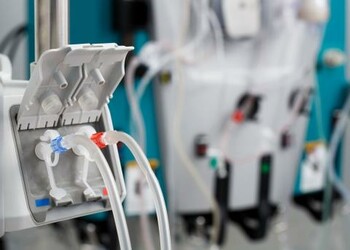New Technique Clears Hemodialysis Catheter Clots
CAMBRIDGE, MA—Reports from the CDC indicate that about 30 million US adults suffer from chronic kidney disease—and every 24 hours, more than 300 people begin dialysis treatment for kidney failure. While dialysis can replace the kidney’s filtering function, it can also lead to complications, such as bacterial colonization, biofilm formation and protein adhesion in the catheter.
To reduce the protein buildup and biofilm formation and extend the life of catheters, Draper developed a new technique called water-infused surface protection, or WISP, and tested it on a central venous catheter (CVC), the most commonly used catheter for hemodialysis. WISP creates a blood-free boundary layer of purified fluid on the inner surface of a CVC that prevents protein buildup and removes proteins that adhere to the catheter.
“Such precision therapies may one day enable us to make dialysis safer and less expensive. For example, antibiotics delivered through the WISP membrane can mitigate infection and do it without resorting to catheter removal,” said David Sutherland, a biomedical and mechanical engineer who helped to develop WISP as a Draper Fellow and Ph.D. candidate at Boston University. “The WISP method also allows delivery of anti-coagulant and thrombolytics, which can break down and remove the thrombotic buildup on the catheters, which is a major cause of CVC failures and is a factor that makes treating infections difficult.”
In benchtop tests using models representing CVCs, the WISP method reduced average protein surface density by 92 percent when compared with a CVC in a non-WISP condition. A cleaner boundary layer can result in reduced thrombosis formation and platelet activation and extend the life of a CVC, noted Joseph Charest, Ph.D., a biomedical engineer at Draper who co-wrote a paper on WISP with Sutherland and Xin Zhang, a professor of mechanical engineering at Boston University.
“WISP shows promise for patients and care providers as a way to limit the costs and health risks associated with dialysis, and for medical device companies as a promising technology for designing the next generation of catheters,” Charest said. “Because it is compatible with current CVC dialysis systems, WISP can improve the quality of life for dialysis patients and care providers who operate and maintain dialysis machines.”
The WISP central venous catheter is part of an integrated portfolio of technologies and resources at Draper intended to help government, industry and academia make better use of biomedicine. The company is working with pharmaceutical companies on drug discovery and development; medical device developers to provide clinicians with quantitative diagnostic data at bedside to help them diagnose their patients’ illnesses more accurately and quickly; and biomanufacturing companies on increasing the speed and reducing the cost of processing cell therapies.
Released July 19, 2018

